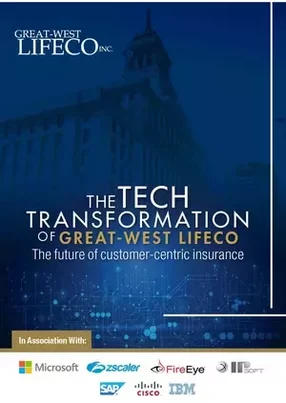Embracing the future, respecting the past: Great-West Lifeco’s digital transformation
For any organization, of any size, undergoing an extensive digital transformation is no small feat.
For Great West Lifeco Inc. (Lifeco) and its Canadian-based companies, which have been providing insurance, benefit and financial solutions to Canadians for more than a century, the challenge centres upon maintaining a promise the company has made since it was founded.
“As a company, we've long offered a promise to our customers – to improve their well-being, to keep their personal information safe, and to be there when they need us most,” says Philip Armstrong, Executive Vice-President and Global Chief Information Officer (CIO). “Our digital transformation is all about building upon this promise. We’re strengthening how we protect customer data and investing in new digital solutions that will provide convenient service for our customers anytime, anywhere.”
As Global CIO, Armstrong’s role is crucial in the delivery of this transformation. Lifeco has carefully selected technology partners like Cisco, SAP, IBM, Microsoft, FireEye, Zscaler and IPSoft to completely transform its entire technology ecosystem. Armstrong feels strongly that the role of the Global CIO has also significantly evolved alongside this journey.
“Traditionally, I think that companies first created a business strategy and then looked at how technology could underpin and support that strategy,” he says. “Today, with technology moving so fast, technology is a key driver in determining business strategy. The CIO is now expected to actively partner in the business transformation process, from design to execution.”
Lifeco is a global provider of financial services, comprised of a number of companies that operate predominantly in Canada, Europe, and the US. Armstrong is tasked with overseeing a number of regional CIOs together with motivated technologists located around the globe.
“We have approximately 3,400 technologists within our core technology teams,” he says, “and we’ve recently aligned them closely with our different business groups; this blurs the lines between what would traditionally be a technical or a business role. This alignment helps us be more agile and outcome based. It allows our business to better leverage technology to meet the future needs of our customers.”
The changing face of technology
Technology has always been Armstrong’s first passion. He began his career working on the frontlines of technology in England in 1979, before the personal computer arrived on people’s desks. He quickly rose through the ranks, becoming the CIO of a leading Toronto based financial services company at the age of 29. Since then, his technology career has provided him opportunities to visit and work in 48 different countries.
Armstrong has seen first-hand how technology has evolved over several decades and how each new wave of advancement has influenced business models. He argues that one of the most significant changes has been how we now perceive technology’s potential.
“In the early days, I watched as technical solutions were positioned with rampant overselling, which led to unrealistically high expectations and the inevitable disappointment of broken promises,” he says. “Today’s technology platforms are so powerful that their potential is often ahead of what most companies need. There’s never been a more exciting time to work in the technology field and turn that potential into a reality.”
Armstrong joined Lifeco as Global CIO in 2016 to advance the company in how they could leverage technology across their group of companies.
“It’s about changing how we apply technology to provide modern timely services for our customers,” he says. “We believe strongly in putting the customer at the centre of what we do, and that translates into the decisions that we make around what technologies and services we intend to roll out.”
Lifeco’s Canadian companies have served Canadians for more than a century, and Armstrong says their transformation is really about positioning them for the future.
“We’re embracing the future, while respecting our past. We have a proud heritage of helping Canadians with services and expert financial advice. We’re looking to use the power of technology to find new ways to improve the financial, physical and mental well-being of our customers.”
Evolving customer needs
Armstrong believes that while customer expectations of technology have risen, many aspects of the financial services industry have been slow to respond.
“The modern customer wants immediate access to their financial information augmented with timely advice that empowers them to make better decisions,” says Armstrong. “Advice-based insurance and wealth management business models within Canada have approached technology cautiously, fearing it would provide an unnecessary barrier that gets in the way of what is a very personal relationship between financial planners, advisors and the customer.”
But according to Armstrong, Lifeco isn’t shying away from this challenge, and instead, views it as a strategic opportunity.
“We’re listening very closely to both our customers and financial advisors. We see emerging technology as an opportunity to significantly enhance these personal relationships that are so important to our overall success.”
The company is listening intently to its customers, identifying their pain points and building a technology ecosystem that can rapidly respond and adapt to the customers’ wants and needs.
“It’s a modernization process that starts from front to back,” says Armstrong. “You have to examine how your customers are interacting with you, and many of ours do so through intermediaries. We have to equip financial advisors and our distributors with digital solutions that enable them to be more productive, more informed, and more connected, so they can provide exceptional service to their customers.”
“Where it makes sense, we’re helping advisors and clients by providing customers with new digital self-service capabilities. Within our own business operations, process automation, machine learning, data analytics and AI technologies are helping to streamline and reduce business processing costs, enhance responsiveness, and increase employee productivity.”
Rising customer expectations and the industry’s competitive landscape are also reshaping the way Lifeco approaches systems and solutions delivery.
“Our technology development process was much more inward looking, today it’s a more organic process that has to be closely aligned with what customers want, need and expect. ”
Armstrong points to how Agile development methodologies and ways of working are becoming the preferred way at Lifeco, bringing together cross-functional, full-stack teams that are able to deliver quickly. To him, this is often the biggest cultural change.
“It’s no longer good enough to work on requirements, develop code, wait six months, and then present the result – the traditional waterfall approach. There needs to be shorter, sharper sprints, allowing us to reduce execution risk and respond to opportunities in the marketplace as they happen.”
The art of the possible
Armstrong emphasized the importance of aligning Lifeco’s strategic business plan and technology vision.
“I consider myself to be living in the future, my job is to envision what could be and then partner with my business colleagues to define the art of the possible,” he says. “We have a clear business vision, but marrying that vision with emerging technologies often drives new possibilities that weren’t previously considered.”
“Working this way requires a major cultural change, operating model re-alignments and a more flexible organization structure. This has been a major part of our transformation journey. It’s vitally important to know where you’re going and having everyone aligned towards that goal. That congruence of vision, action and technology is how you start to move from where you are today, to your destination in the future.”
A transformational journey
For Lifeco’s Canadian companies this latest transformation represents one of the biggest turning points in their illustrious history. They’re working to reinvent the organization’s core technologies and business processes, many of which have been successfully operated for decades.
With every major component of technology now in a state of flux, being replaced, modernized, moved to the cloud, or retired; surely this creates a higher level of operational risk?
“I think it’s far riskier not to change,” says Armstrong. “Indeed, we are acutely aware of how well these transformation activities and risks need to be managed, but we’re also aware of our industry’s future direction. We know its advancement will be largely fuelled by technology innovation. We’re not going to wait for the industry to change, we want to be proactive and drive this change.”
“I don’t know of a larger technology-based transformation happening within financial services across Canada right now. Our digital and business transformation will differentiate our company and position us to remain competitive going forward.”
A vital part of Lifeco’s strategy has been to establish strong partnerships with leading global technology providers including Cisco, Microsoft, IBM and SAP. Through these strategic partnerships, Lifeco has been able to leverage their partners’ R&D capacity and gain access to some of technology’s biggest and brightest talent pools.
“We work closely with our large technology partners, spending time to understand their solutions and roadmaps, and then applying suites of integrated technology to business challenges and opportunities. This avoids spending most of our time trying to integrate disparate technology solutions, forcing them to work together.”
“For us, this is an efficient model where we leverage the expertise offered by these large technology partners, and they've been fantastic to work with.”




